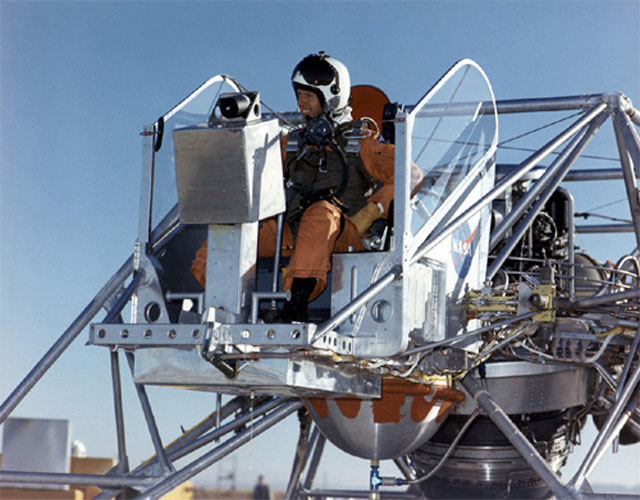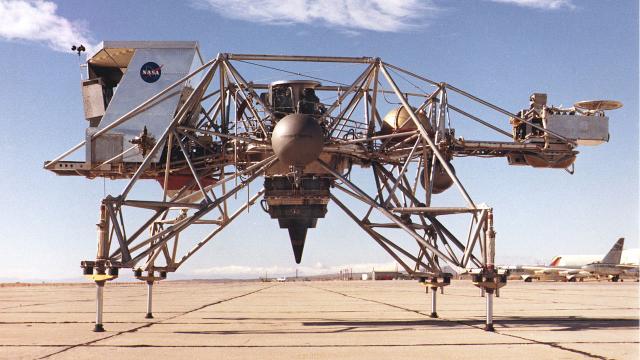In the early 1960s, when the Apollo missions were underway and America was hellbent on reaching the moon, NASA researchers faced a nearly endless litany of technical hurdles and engineering obstacles nobody had even dreamed of up to that point. Chief among them: Once you shoot three guys 380,000km across space at an orbiting body with just a fraction of the mass of Earth, how do you put them safely on the surface? That answer: lots and lots of practice in this gangly hardware simulator.
Known as the Bell Aerosystems Lunar Landing Research Vehicle (LLRV) and operated out of the NASA Dryden Flight Research Center, at Edwards Air Force Base, California, this 3m tall, 7m long, 4m wide simulator trained virtually every pilot in the Apollo program to operate the lunar lander in micro-gravity environments without actually requiring the micro-gravity environment. As Donald “Deke” Slayton, who headed the NASA astronaut office during the early Apollo days, once quipped, there was “no other way to simulate moon landings except by flying the LLRV.”

To accurately recreate the conditions that astronauts would likely face on the moon’s surface, the aluminium-trussed LLRV was outfitted with a 475Nm gimballed General Electric CF700-2V turbofan engine that always pointed towards the ground and could be throttled back to support only five-sixths of the simulator’s weight, recreating lunar gravity. The rest of the unit’s weight was supported by a pair of 56Nm hydrogen peroxide-driven lift rockets (for descent and horizontal movement) and a series of 16 smaller Hypo rocket engines that controlled LLRV’s bearing and orientation. This helped astronauts develop the sensitive touch required for real landings. All of the pilot’s controls were input using a single three-axis, side-arm, fly-by-wire controller similar to the actual lunar landing module.
It was also outfitted with an ejection seat in case anything went wrong, as it did in 1971 when when the Hypo delivery system failed and Neil Armstrong had to bail. The ejection seat, built Weber Aircraft LLC was one of the first zero-zero ejection seats able to throw its occupant up to safe parachute altitude (about 75m) even when on the ground (it just required a half second of acceleration under a 14g load).
Ten minutes at a time (which was all the endurance the Hypo reserves could muster), every Apollo mission commander and their backups trained for their lunar landings in the LLRV. They also underwent three weeks of helicopter flight school as well as tethered training flights on Langly’s lunar landing simulator and on the electronic ground simulator at the Manned Spacecraft Center (now Johnson Space Center).

The LLRV, though awkward in appearance, was packed with the most sophisticated sensors and computational hardware available at the time. This flight correction system, collectively known as “Lunar Sim Mode” was able to make millisecond-quick corrections to the craft’s flight performance, even cancelling out the effect of wind (since there isn’t any on the lunar surface).
“As a general statement concerning the translation ability on earth versus the translational ability in the lunar simulation; the vehicle is reduced from a very positive high response vehicle to a very low or weak response vehicle,” FRC test pilot Don Mallick reported after his first flight in Lunar Sim Mode. “I’m sure with training and experience the pilot will be able to increase the overall vehicle-pilot performance once he adapts to the low translational accelerations that are available, as well as the lag that follows along with the anticipation that is required to properly control the vehicle.” And it would appear that with the continued success of the Apollo program, Mallick’s predictions proved quite true. [NASA 1, 2– Wiki]
